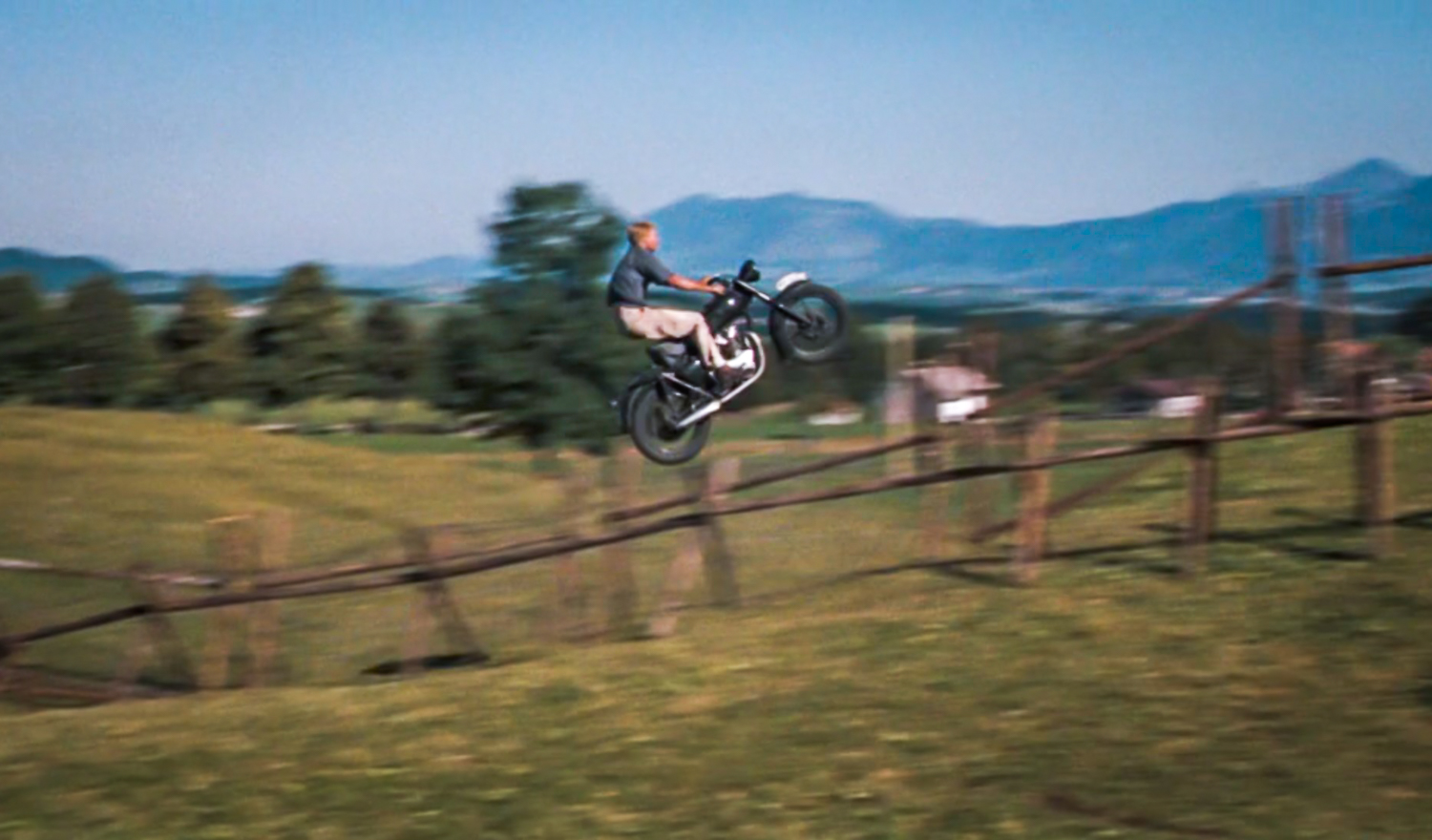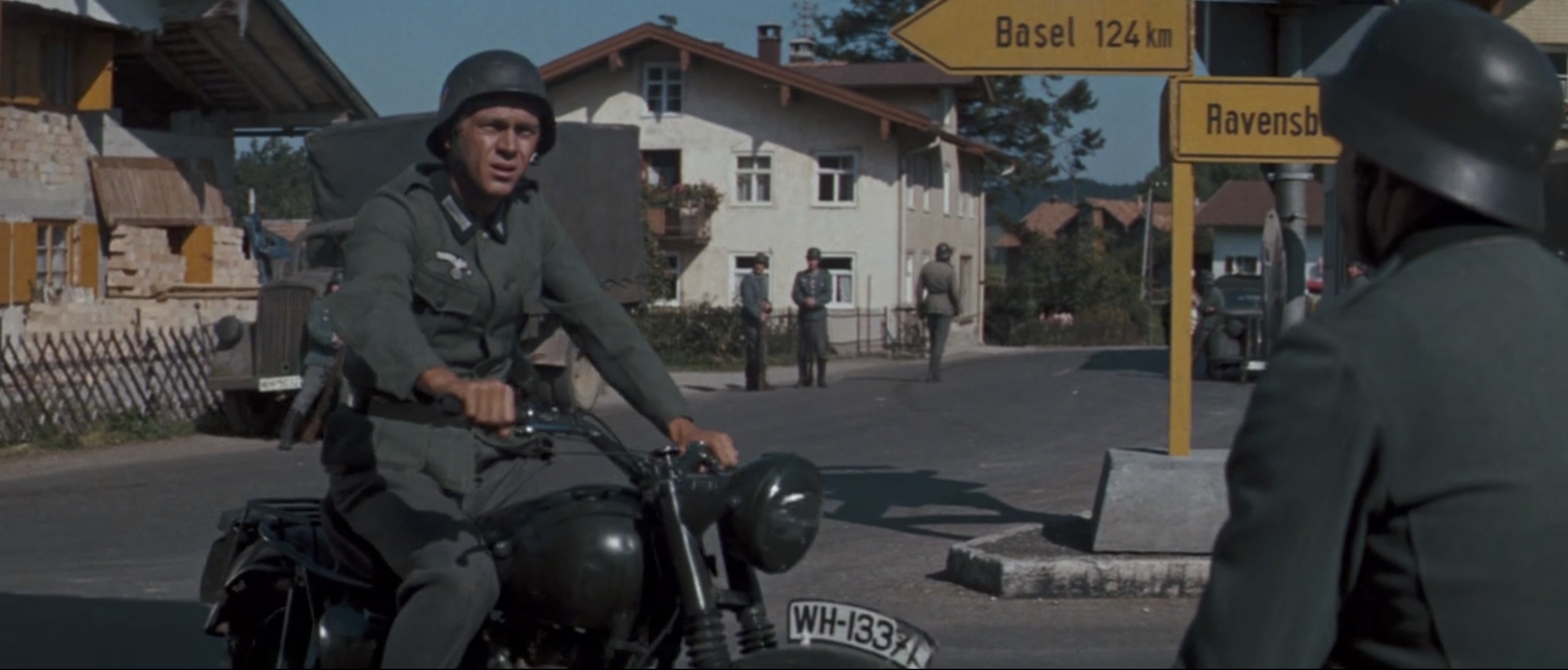The Great Escape is how Steve McQueen outfoxed studio lawyers and kept having fun
At the threshold of Steve McQueen’s stardom, a studio attorney gave him just a day to make a life-altering decision: racing or acting. If McQueen were to become a true leading man, he’d have to play it safe and sacrifice the race track. “They gave me twenty-four hours to make up my mind,” McQueen recalled. “I took most of those twenty-four hours thinking about whether I wanted to go on racing, earning my money on the track, or whether I wanted to continue being an actor on the studio’s terms. It was a very tough decision for me to reach. Still, I had Neile and our two young children to consider, and that made the difference. I signed their paper.”
With 1963’s The Great Escape, Steve McQueen established a career built on outfoxing his contract. He may have been unable to race for real, but he could still race in the movies. And The Great Escape was the first of such ruses — director John Sturges and McQueen “worked a hairy motorcycle chase” into the film for McQueen’s character Virgil Hilts, nicknamed the Cooler King due to the time he spent in solitary confinement. McQueen described it himself, “The idea was this Cooler King character makes good his escape by stealing a cycle, gets chased cross-country by German cyclists and loses them by jumping this big barbed-wire fence with this bike.”
The bike jump in The Great Escape is legendary, but Sturges’ film is a masterpiece in its own right, based on the true story of Allied airmen’s daring escape via tunnels from Stalag Luft III during World War II. Though McQueen is ostensibly the star, the film belongs to its ensemble cast, a dream team of 1960s masculine icons and legendary actors that included James Garner, Charles Bronson, James Coburn, James Donald, Donald Pleasence, David McCallum, and Richard Attenborough. On its surface, The Great Escape seems to be a war film, but at its heart, it’s a heist movie flipped on its head: a group of specialists team up to make a plan with nothing but their ingenuity – though instead of breaking in, they’re breaking out of a German POW camp. It’s also the ultimate underdog story, a film about camaraderie, courage, self-sacrifice, and giving the enemy hell.




The Great Escape brought together some of the most prominent gearheads of the 1960s, and by all accounts, the testosterone on the set was out of control. Charles Bronson started an affair with David McCallum’s wife Jill Ireland. Steve McQueen frequently fought for changes to the script, and even took issue with his rival James Garner wearing a more handsome outfit. Even Donald Pleasence brought his Jaguar with him to Germany. According to David McCallum, “Everyone drove like a maniac, including Donald Pleasence. [ . . . ] But Steve was the guy – mirroring the film, almost – who took the most risks and had the traffic police in awe of him. When he was pulled over they’d say, ‘Herr McQueen, good morning, we’re delighted that once again you’ve won the special prize,’ and cart him off to the jail. Once I asked him what he did in a crash. He told me you should aim for the smallest trees.”
Tom Adams, who played RAF officer Dai Nimmo, put it plainly: “Steve McQueen was as mad as a hatter. He wrote off six or seven cars out there.” Though it may have made him difficult behind the scenes, McQueen channeled his reckless thrill-seeking, his penchant for getting locked up, and his love for bikes into his performance and character.
Stuntman Bud Ekins was as essential to The Great Escape as Steve McQueen himself. McQueen met Ekins when he bought a Triumph motorcycle from him, started hanging out at Ekins’ shop, and as a result discovered desert racing. It was McQueen’s idea to fly Ekins out to Bavaria where they were shooting The Great Escape. “He said, ‘I’m going to Germany and I’m going to make a movie. Do you want to come over and double me? There’s some motorcycle work in it.’ I said, ‘Sure,’ and that was about it.” It would be the first of many films Ekins and McQueen made together.

Bud Ekins prepared and choreographed the bulk of the chase, and McQueen did most of his own riding. McQueen was a better driver than many of the stuntmen playing Germans, so he put on an SS uniform for some of these scenes and chased himself. As Hilts, he rode a 1962 650cc Triumph TR6R. Production used four bikes total, modified to look like a WWII-era side-valve BMW with an olive paint job, old seat, and luggage rack. The studio’s insurers took issue with McQueen doing anything too dangerous, so Ekins doubled him for stunts where McQueen could have been hurt. Ekins also brought along Australian motocross champion Tim Gibbes, who played the Nazi officer who crashes after Hilts sets a wire trap in the road. Hilts steals Gibbes’ SS uniform and motorcycle and heads for Switzerland. On his way toward the border, he draws the unwanted attention of German officers who try asking questions that he can’t answer. Hilts kicks one of these officers off his bike and speeds away, with countless Nazis in pursuit.
Though McQueen is famous for The Great Escape’s most famous stunt, it was Bud Ekins who performed it. McQueen explained, “I always felt a little guilty about that. A lot of people thought it was me making that jump, but I’ve never tried to hide the truth about it. I could handle the jump now, I’m sure. Back in ’62, I just didn’t have the savvy.” According to a few of his castmates, McQueen did have the savvy. John Leyton, aka Willie “The Tunnel King,” had his own story about palling around with McQueen, Coburn, and Bronson after the cameras stopped rolling. The men rode motorcycles together and they all managed to make the jump, aided by a ramp dug in the hill that Ekins had used as a launch pad. McQueen performed the stunt at least one other time, on camera, just to prove that he could, and Tim Gibbes did it for fun. According to second unit director Robert E. Relyea, McQueen, Ekins, and Gibbes were all filmed performing the stunt.



Relyea wrote in his book Not So Quiet on the Set that he believes it could be any of these three men doing the stunt featured in the final cut, but most believe that it’s Bud Ekins on film. Ekins sped his way up and over the barbed-wire fence, jumped 12 feet high, and descended 65 feet at 60 mph. It only took one take for Bud Ekins to pull it off. Ekins said, “When I took off, I throttled right back and it was silent. You know, everything was just silent – the whole crew and everything was just silent. And then when I landed they cheered like crazy.” With Hilts surrounded on all sides by Nazis, this moment has the highest stakes imaginable, and though Hilts is ultimately captured, it is euphoric when he first makes it to the other side.
The motorcycle jump is essential to The Great Escape’s legacy, a historic moment in moviemaking. It became an image seared into our collective memory, emblematic of liberation and the brief exultation of those who made it out of the prison camp. But their escape came at a cost, as the Gestapo executed the majority of the escapees. At the end of the film, Hendley asks Senior British Officer Ramsey (James Donald), “Do you think it was worth the price?” Ramsey responds, “It depends on your point of view.” Jack Lyon, a real RAF officer who’d been imprisoned at Stalag Luft III, believed the mission boosted morale at the camp, as the men felt they had a purpose, that they contributed something. Ramsey argues they succeeded in their mission: to mess up the works, and to get back at the enemy the hardest way they could.










This article about “The Great Escape” is as excellent of an article as the movie itself. My most sincere compliments on an informative and amazing article. Thank you so much for this article.
The piece about “The Great Escape” is a brilliant article on the movie and of course Steve McQueen, who has been my favourate actor for many years.